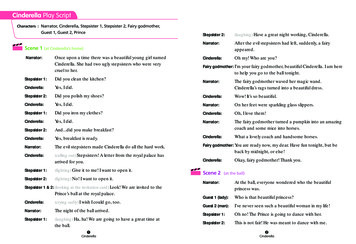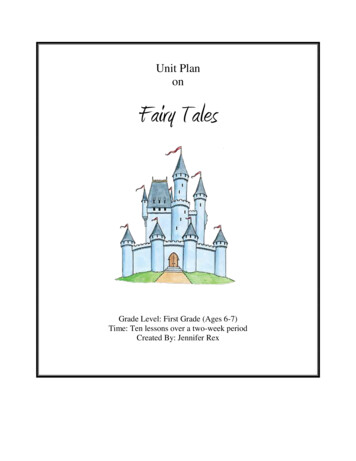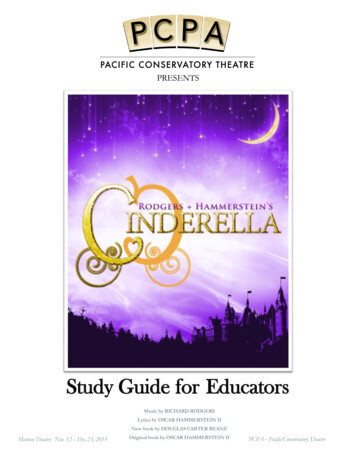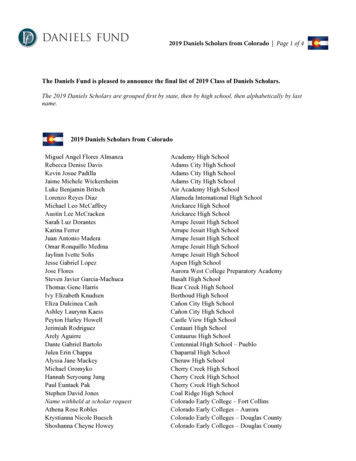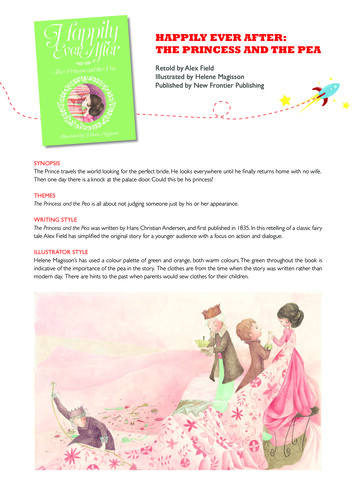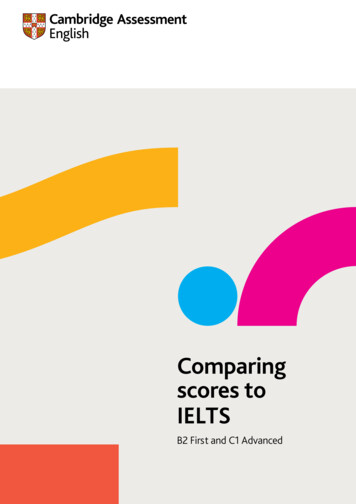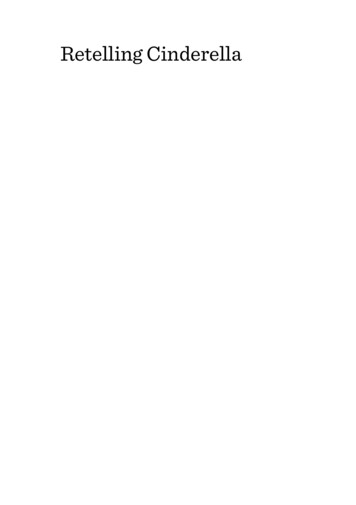
Transcription
Retelling Cinderella
Retelling Cinderella:Cultural and CreativeTransformationsEdited byNicola Darwood and Alexis Weedon
Retelling Cinderella: Cultural and Creative TransformationsEdited by Nicola Darwood and Alexis WeedonThis book first published 2020Cambridge Scholars PublishingLady Stephenson Library, Newcastle upon Tyne, NE6 2PA, UKBritish Library Cataloguing in Publication DataA catalogue record for this book is available from the British LibraryCopyright 2020 by Nicola Darwood, Alexis Weedon and contributorsAll rights for this book reserved. No part of this book may be reproduced,stored in a retrieval system, or transmitted, in any form or by any means,electronic, mechanical, photocopying, recording or otherwise, withoutthe prior permission of the copyright owner.ISBN (10): 1-5275-5943-2ISBN (13): 978-1-5275-5943-1
This book is dedicated to our friend and colleague Giannandrea Poesiowhose grand battement jeté led us to this grand allegro, but who did notsee our opening night.
TABLE OF CONTENTSList of Illustrations . ixAcknowledgements . xiNotes on Contributors. xiiIntroduction . xvNicola Darwood and Alexis WeedonChapter One . 1The material culture of Cinderella: Introducing the Cinderella collectionAlexis WeedonChapter Two . 16The transformation of a Disney Princess into its parodic meme:A case study of the cultural transduction of the Cenicienta costeñaEnrique Uribe-Jongbloed and César Mora-MoreoChapter Three . 34Tinderella, a modern fairy tale of online dating and post-feminist mediacultureMarta Cola and Elena CaoduroChapter Four . 49Losing your footing: The transformation of gender roles and genderideology in Marissa Meyer’s CinderNicky DidicherChapter Five . 67Mythic transformations on screen: Cinderella meets GalateaEleanor AndrewsChapter Six . 87Tailoring Cinderella: Perrault, Grimm and their beautiful heritageSally King
viiiTable of ContentsChapter Seven. 111‘A Grand Christmas Pantomime’: Nancy Spain’s Cinderella Goesto the Morgue: An EntertainmentNicola DarwoodChapter Eight . 130Real princesses in Anne Thackeray Ritchie’s Five Old Friendsand Frances Hodgson Burnett’s A Little PrincessRebecca MorrisChapter Nine. 149Representations of Cinderella as myth and folklore in Spanishversions of the taleMaia Fernández-LamarqueChapter Ten . 167Helped by a honeybird, clothed in catskins, and swallowed by a whale:Exploring the Irish variants of the Cinderella taleDonna GilliganChapter Eleven . 185Creative reflection: Cinderella—the ultimate domestic narrativeVanessa MarrChapter Twelve . 207‘Prom Night: Cinderella Gets a Gun’: A story and creative reflectionLesley McKennaWorks from the Cinderella Collection . 223Bibliography of Works Cited . 230Index . 251
LIST OF ILLUSTRATIONSFig. 1-1. Google ngrams chart of the occurrence of Cinderella in Englishtext corpus. Source: http://books.google.com/ngramsFig. 1-2. Inside front cover and book opening showing Cinderellapanorama book: six magnificent scenes, Collins c.1950, AlexisWeedon.Fig. 1-3. Raphael Tuck’s postcard, annotated by sender. In the CinderellaCollection, University of Bedfordshire. Alexis Weedon.Fig. 2-1. Example of one of the many Cinderella of the Coast MemesFig. 2-2. Cenicienta costeña’s Sobusa line bus travels image by#QuilleraVaciladora from https://goo.gl/6V5qJWFig. 7-1. Programme for Hampton Court’s production of Cinderella at theTheatre Royal, Newchester, from Spain, Cinderella 7.Fig. 10-1. ‘Trembling at the church door’: an illustration of “Fair, Brown,and Trembling” by John D. Batten for Joseph Jacob’s “CelticFairy Tales”, 1892, public domain.Fig. 10-2. ‘Trembling is cast out by the whale’: an illustration of “Fair,Brown, and Trembling” by John D. Batten for Joseph Jacob's“Celtic Fairy Tales”, 1892, public domain.Fig. 10-3. Irish 5p postal stamp, 1922/1923, showing an illustration of ‘AnClaidheamh Soluis’ (The Sword of Light), public domain.Fig. 11-1 Embroidering a duster, Vanessa Marr, 2014Fig. 11-2. What is Woman’s Work, Vanessa Marr, 2014.Fig. 11-3. Once Upon a Time, Vanessa Marr, 2014Fig. 11-4. Seven hand-embroidered dusters, Vanessa Marr, 2014.Fig. 11-5. a: Apron, b: Iron, c: Thimble, d. Scissors, Vanessa Marr, 2014.Fig. 11-6. Duster Happily Ever After This is not the End, Vanessa Marr,2014Fig. 11-7. Embroidering dusters in a workshop that accompanied anexhibition of the dusters in 2017, Vanessa MarrFig. 11-8. A selection of dusters on display at the University of Brighton,2017, Vanessa Marr.Fig. 11-9. A selection of dusters from the collection on display at the DeLa Warr Pavilion, Bexhill-on-Sea, March 2016, Vanessa Marr.Fig. 11-10. Rubber Glove – You shall go to the Ball! Vanessa Marr, 2014.Fig. 11-11. There’s No-one Like her, Vanessa Marr, 2018.
xList of IllustrationsFig. 11-12. When I’m feeling domestic I put my Pinny on, Ana Valls, 2015.Fig. 11-13. Be a Good Girl, Vanessa Marr, 2017.Fig. 11-14. Is this Domestic Bliss? Vanessa Marr, 2016.Fig. 11-15. The Many-Handed Woman, Vanessa Marr, 2016.Fig. 11-16. Be just like Daddy Mummy, Jenny Embleton, 2016.Fig. 11-17. All you need is a Magic Wand, Angela Paine, 2015.Fig. 11-18. We all need to do our bit, Joanna Kerr, 2015.Fig. 11-19. In the Land Faraway, Dreams Come True, Vanessa Marr,2014.Fig. 11-20. Fairy Tale Castles in the Sky, Vanessa Marr, 2017.Fig. 11-21. Scrubber, Vanessa Marr, 2017.
ACKNOWLEDGEMENTSThere is a moment when every book has a beginning: a transformationscene. We vividly recall the personalities and excitement, the setting alightof intellectual fireworks and curlicues of imagination. The donation of acollection of Cinderella material sparked an idea over coffee with ourfriend and research director, Giannandrea Poesio. It was his imaginationand enthusiasm for the initial project (an interdisciplinary, internationalconference) that lit the initial match, but the flames were added to by anexcited group of people, all colleagues or former colleagues at theUniversity of Bedfordshire including: Torsten Anders, Elena Caoduro,Luke Hockley, Carlota Larrea, Mark Margaretten, Karen Randell, PaulRowinksi, Sarah Stenson, Victor Ukaegbu and Clare Walsh. We took thisflame of an idea to our colleagues in the library whose care anddocumentation of the collection and the loan of pieces for the conferencemade it something different: Karen Davis, our archivist; Sarah Arkle, ourHead of Reader Services; and Marcus Woolley, our Head of LearningResources. The conference attracted many of the scholars whose work youhave here and we thank them for their generosity and conviviality at thattime and to this. Others have contributed to the event and subsequentdiscussion and we would like to thank for their support: Professor MaryMalcolm who despite her responsibilities as a senior manager has createdthe time to join us at the conferences and in discussions of the ResearchInstitute and Mrs Stowe, benefactor of the Cinderella Collection, withoutwhom none of this would have been possible. We are particularly gratefulto Elena Caoduro for her involvement throughout this project until themore important task of parenthood took her time. And on that personalnote, we would also like to acknowledge the support of our families who,once again, heard that immortal phrase ‘just one paragraph to go’.
NOTES ON CONTRIBUTORSEleanor Andrews is a retired senior lecturer in Italian and Film Studies atthe University of Wolverhampton, UK. She taught French Cinema,including Poetic Realism and the Nouvelle Vague, and Italian Cinema,including Neo-Realism and the Spaghetti Western. Her book on Italiandirector Nanni Moretti’s use of narrative space, Place, Setting, Perspective,was published in 2014. She is co-editor of Spaces of the Cinematic Home:Behind the Screen Door (2015). Her other research interests include theHolocaust and disability in film.Elena Caoduro is lecturer in Media Analysis at Queen’s UniversityBelfast. Her research on memory, nostalgia and European cinema has beenpublished in journals such as Networking Knowledge, Alphaville Journalof Film and Screen Media and NECSUS: European Journal of MediaStudies.Marta Cola is a principal lecturer in Mass Communications andPostgraduate Portfolio Leader at the University of Bedfordshire, UK. Sheteaches Television Studies at undergraduate level, and research methodsand media institutions at postgraduate level. Her research interests includeaudience studies, diaspora studies, media and identity.Nicola Darwood is a senior lecturer at the University of Bedfordshire, UKand leads the undergraduate programme in English Literature, teachingcourses on Ulysses, modern Irish Literature, the Gothic, and Restorationand Eighteenth Century Literature. Her research focuses mainly ontwentieth century women writers and she has published work on ElizabethBowen and Stella Benson. She is currently particularly interested in theuse of humour in fiction. She is the co-founder and co-chair of theElizabeth Bowen Society, and the co-editor of The Elizabeth BowenReview.Nicky Didicher is a lecturer in English literature at Simon Fraser Universityin British Columbia, Canada, specializing in pedagogy, children’s andyoung adult literature, and eighteenth-century British literature.
Retelling Cinderella: Cultural and Creative TransformationsxiiiMaia Fernández-Lamarque is a full professor at Texas A&M UniversityCommerce and a Distinguished Global Scholar. She has publishedextensively in the field of critical theory on comparative cultural studies.She is the author of Espacios posmodernos en la literatura latinoamericanacontemporánea (Argus-A 2016) and her book, Cinderella in Spain:Variations of the Story as Socio-Ethical Texts was published in 2019.Donna Gilligan is a museum professional, heritage educator, and materialculture historian who has worked in in a number of roles in the heritageand museum sectors over the past fourteen years. She specialises in workwith historical and archaeological artefacts and museum collections, andhas a strong research interest in Irish folklore, legends and mythology. Sheholds a B.A. and M.A. in English and Archaeology, an M.A. in MuseumPractice and Management and an M.A. in Design History and MaterialCulture.Sally King is a third-year PhD student at De Montfort University,Leicester, UK. Her thesis examines the representation of the slipper intranslations and adaptations of Cinderella, and its evolution since the talesof Charles Perrault (1697) and the Brothers Grimm (1812-1857). She isinterested in adaptations in film, toys, dance and pantomime.Vanessa Marr is a senior lecturer in Graphic Design, Illustration andFashion Communication with the University of Brighton, UK. Herprofessional experience includes working for Dorling Kindersley as an ArtEditor and running her own successful design agency for 8 years. An M.A.in Sequential Design and Illustration refocused her practice, whichunderpinned by visual design-theory and process, embraces an intuitiveand practical approach, facilitating both self-authorship and collaborativeinvestigation.Lesley McKenna is a senior lecturer in Creative Writing at the Universityof Bedfordshire, where she teaches specialist modules in Writing Horrorand Dark Fantasy Fiction; and Writing Fantasy Fiction. She has a BA firstclass honours in Creative Writing; and gained a distinction in her Mastersby Research degree in 2008. The resulting novel, Clutching Shadow, astory of incest, betrayal and death, was long listed for the Cinnamon Pressnovel prize in 2008. Lesley is also a published prose poet. She is currentlyworking on a Lovecraftian-inspired dark fantasy project that exploresdreams, dreamers and the dreamlands.
xivNotes on ContributorsCésar Mora Moreo is a student of Social Communication and Journalismin Universidad del Norte, Barranquilla, Colombia. He serves as ResearchAssistant at the Department of Social Communication in subjects relatedto cinematographic analysis, literature, journalism and scripts.Rebecca Morris is a postgraduate student at the University of Hull. She iscurrently working towards a PhD in children’s literature and the workingtitle of her thesis is ‘Little Princesses and Schoolgirl Witches: Girl Heroesand the Fairy-tale Tradition in Children’s Fiction’. She specialises inchildren’s and young adult literature and has research interests in theVictorian period, early twentieth century fiction and American women’swriting.Enrique Uribe-Jongbloed has been a full professor at Universidad deBogotá Jorge Tadeo since 2017 and was formerly professor and researcherat the Department of Social Communication in Universidad del Norte,Barranquilla, Colombia. He obtained his PhD from the Department ofTheatre, Film and Television Studies at Aberystwyth University, Wales, in2013. His research interests include identity, language and mediaproduction. He edited the book Social Media and Minority Languages.Alexis Weedon is professor of publishing and UNESCO chairholder inNew Media Forms of the Book at the University of Bedfordshire, UK. Sheis the author of Victorian Publishing: The Economics of Book Productionfor a Mass Market 1836-1916 (2003) editor of The History of the Book inthe West (2010), co-editor of Convergence (1995-2017) and co-author ofElinor Glyn as Novelist, Moviemaker, Glamour Icon and Businesswoman(2014), and writes on publishing, the book as media, and cross-mediastorytelling.
INTRODUCTIONNICOLA DARWOOD AND ALEXIS WEEDONIn both Harper’s Bazaar and Maclean’s Magazine in March 1932 there isa full-page advert for a ‘Coach for Cinderella’. The body styling, uses ofcolour, attention to upholstery, interior trim, fittings and equipmentconveniences of this gorgeous concoction, we are told, have ‘had thedemands of feminine censorship as their standard’. The Coach is in fact aluxury car and the company, Fisher Bodies, is targeting the feminine tastesof the emancipated woman: ‘Freed after untold centuries from the narrowrestrictions of a purely domestic life, she has emerged, like a radiantCinderella, into a broader, finer, more beautifying existence’. In this oneadvert we can see the confluence of themes which surround the Cinderellastory: escape from drudgery, wish to travel, the transformation of mundaneobjects into desirable ones, and joyful pleasure of finery (‘A Coach forCinderella’, 51).The story is so well known that it has become a shorthand for theunexpected success of the disregarded: men as well as women, companiesas well as people. Amusingly in the same year as the Harper’s Bazaar andMaclean’s Magazine advert, The Exeter and Plymouth Gazette reported onthe resurgence of fish and chips which was becoming ‘a most respectableas well as profitable business’, ‘ceasing to be Cinderella’. The contrastbetween American and British cultures in the two publications is diverting,but the meaning of the reference transcends both. Today Cinderella’seclecticism is apparent on social media which provides many examples ofcross-cultural use: Instagram’s hashtag #reallifecinderella featureseverything from personal stories to shoe art and the framed motivationalquote to ‘set my goals and achieve them all’. A similar search on Twitterloads references to dating, weddings, make-overs, party dresses, shoes(lost and found), moments of change in life, and overcoming the odds.Disney .gifs have become digital motifs to communicate feelings ofdrudgery (cleaning), the pleasure of giving (mice helpers), the doom ofdeadlines (midnight clock), greed (Lucifer’s gambling), and the momentthe shoe fits as something comes right. Overall, social media use showshow the term is still being morphed and made relevant in the modern-day.
xviIntroductionThe essays in this volume reflect on the material and cultural legacy ofthe tale and how it remains active and relevant in many different societieswhere social and family relationships are adapting to modern culture. Itopens aptly with a wander though one person’s collection of Cinderellabooks, objet and ephemera from across the world which has been donatedto the University of Bedfordshire. The Collection holds materials rangingfrom opera and ballet programmes, books and theatre models, tocollectable figurines, toys and merchandise which convey the wide varietyof adaptations and performances that the story has inspired. These werenot simply bought, they were the product of a singular interest in the taleover many years and demonstrate how her passion caused the collector togo to The Royal Ballet and attend a pantomime on the same theme, savethe plastic key ring of a crystal shoe and treasure a china figurine. Itgathers together contemporary kitsch and original editions of the earliestretellings.So we took the lead from the collection and structured the book so thatthe reader moves from contemporary forms of Cinderella back in time. Westart with Cinderella as a parodic meme. The frames from the Disneyanimation have become the creative substrate for mobile memes circulatedfrom phone to phone in Colombia. For comic effect these memes reversedthe mild-mannered Cinderella of the children’s story, creating a foulmouthed sassy character. This cultural transduction and appropriation isinvestigated by Enrique Uribe-Jongbloed and César Mora-Moreo whoseresearch into this phenomena shows how it was localised to specific busroutes and idiomatic dialect. Cenicienta costeña parodies the subservienceof the traditional character, but also the Disneyfication of the tale. Thepassivity of Cinderella has been problematised within a more feministculture. Next in the collection is Marta Cola and Elena Caoduro’s inquiryinto contemporary online dating through the Tinder app and theirdiscussion of the way the feminine derivative term Tinderella has becomememe for women’s proactive dating. They lay out for us the array of spinoffs such as advice blogs, multiple newspaper columns, and personalnarratives in book form written by women of their experiences of finding apartner online. Such an active role for women can be interpreteddifferently in different cultures. It is a theme which Nicky Didicherexplores in chapter 3 as she takes us into the young adult science fictionworld of Marissa Meyer’s Cinder (2012). The novel challenges both ourgender expectations and our moral expectations, enlarging the youngreaders’ spectrum of possibilities. Cinder is a mechanic and a cyborg,more comfortable in coveralls than dresses, and she is incapable ofproducing tears. The ideology of The Lunar Chronicles series promotes
Retelling Cinderella: Cultural and Creative Transformationsxviidiversity and complicates the morality of the traditional Cinderellacharacters which then have to be assessed afresh by the young reader.Nevertheless, it also employs common romance-novel tropes to re-assertthe value of heteronormativity allowing for a conventional happy ending.Moving from the paratextual use of Cinderella to the transformationalnarrative itself, Eleanor Andrews investigates differences between thenotions of change and transformation across versions of Cinderella andPygmalion from Ovid’s poem to a selection of film representationsincluding My Fair Lady (Cukor, 1964), Educating Rita (Gilbert, 1983),Pretty Woman (Marshall, 1990) and Nikita (Besson, 1990). Thetransformation of Pygmalion objectifies her, creating an object for themale gaze, while My Fair Lady and Educating Rita dramatise thetransformative power of education and its ability to overcome thedisadvantages of poverty and class. Filmic and theatrical versions oftenemphasise Cinderella’s transformation through dress and, in the nextchapter, Sally King delves into the early English and German translationsof Cendrillon and Aschenputtel, mining these texts for their references tochanges in fashion, and ideas of beauty and appearance. She highlights thedifferences arising from a small variation in word choice, and she reflectson the intertwining of ideology and sartorial detail while consideringinterlingual and intercultural exchanges which have a significant effect onthe way that women are represented in these different editions.The theatre motif however is never far away and Nicola Darwood’sdiscussion of Nancy Spain’s Cinderella goes to the Morgue: AnEntertainment (1950) draws on a history of pantomime and detectivefiction. She considers Spain’s appropriation of the Cinderella tale in thepost-World War II era, as her characters are embroiled in murder andmayhem in a witty satire on the world of pantomime with all the stockcharacters a reader could possibly hope to encounter. Moving back into thelate nineteenth and early twentieth century Rebecca Morris turns theattention of this collection to the use of the Cinderella motif in the fictionof Anne Thackeray Ritchie and Frances Hodgson Burnett, authors whochose to critique the Victorian ideal of a submissive Cinderella figure andwho used their fiction as a vehicle to comment on contemporary attitudestowards gender, particularly in the light of suffrage campaigns in thesecond half of the nineteenth century.Underlining the undeniable fact that there is not just one version of thestory of Cinderella, Maia Lamarque’s essay continues the exploration ofthe Cinderella tale in a European context as she provides a detailed historyof the story within the history of twentieth and twenty-first century Spain.Tracing the history of the Cinderella story in Spain back to the medieval
xviiiIntroductionvariant, “Estrellita de oro”, and then drawing on a considerable body ofknowledge of the political history of Spain, she considers how therepresentation of the Cinderella figure changed in response to societal andpolitical changes over the centuries, from a conservative representation inthe 1950s to one of political resistance in the twenty-first century. DonnaGilligan focuses on Irish retellings which draw on a rich tradition of Irishstorytelling in both the written and the oral form. Highlighting differencesbetween Perrault and the Grimm Brothers’ versions of the tale, shedemonstrates how the Irish variants blend Irish mythology and folklore,providing a valuable insight into the native traditions and thecontemporary society which enjoyed these tales.We end with two creative pieces: ‘Domestic narratives in Cinderella’scultural translation’, which opens with the creative reflections of VanessaMarr as she considers the tale of Cinderella as ‘the ultimate domesticnarrative’. Discussing her creative practice of embroidering of yellowdusters, she challenges a dominant motif of the Cinderella tale—thatdomesticity is the route to marital happiness—and evokes a catalyst forchange, not just for Cinderella, but for all women. Her essay embroiderstogether practice and theory as she explores her own relationship with boththe material and the cultural environment needed to effect change. Finally,Lesley McKenna’s short story updates the Cinderella tale, setting it withinthe emotional high-stakes of a high school Prom. Her reflection on thethemes of the fairy tale illustrates how the material has limitless flexibilityfor the creative writer. It is an apt ending to this collection of storytellingtransformations of Cinderella.Modern retellings of the story abound: Kenneth Branagh’s live actionCinderella (2015) was set the Disney fantasy world of movie stars in ballgowns and crystal shoes, with a little pantomime humour from thetransformed animals and the pumpkin coach, but Michael Bourne’s ballettouring in 2017–2018 set the story in 1940s wartime Britain, opening withthe cry ‘do not look at the sky’ during air raids: the traditional tale ofmaidenly coming-out at a ball becomes a wartime affair broken off by abomb shell falling on Cinderella and her airman-prince who end uphospitalised. Its radical message of broken families and disruptedrelationships is emphasised by Cinderella’s disabled father, a veteran fromthe previous war. Nevertheless, the deus ex machina, an angel, ensures afairy tale ending, complete with ball gown and fireworks. These recentversions illustrate the continuing duality of the story. The upliftingmessage of Cinderella still sells an increasingly problematic conformity totraditional womanhood by persuading you to buy comfort, aspire to be adomestic goddess or reaffirm the myth of a ‘happy ever after’. But it’s also
Retelling Cinderella: Cultural and Creative Transformationsxixevident that she can also be the symbol for suffrage, for equality andempowerment. We believe that her story will continue to be reused,reappropriated, and refashioned in a way that continues to highlightchanging societal mores and ideologies: always fascinating, for everchanging.Works citedAnon. ‘A Coach for Cinderella’ Harper's Bazaar 1932. Print.—. ‘A Coach for Cinderella’ Maclean's Magazine 1932: 51. /a-coach-forcinderella#!&pid 50 Accessed 20 March 2020.Bourne, Michael, choreographer. Cinderella, 1997, revised and designedfor Sadlers Wells and on tour 2017-2018. Ballet.Branagh, Kenneth, director. Cinderella. Performance by Kate Blanchett,Lily James: Allison Shearmur Productions, Beagle Pug Films, GenreFilms, Disney, 2015.
CHAPTER ONETHE MATERIAL CULTURE OF CINDERELLA:INTRODUCING THE CINDERELLA COLLECTIONALEXIS WEEDONIn August 2012 the University of Bedfordshire was given a collection ofitems all about Cinderella. It was one person’s collection, gathered over anumber of years in the 1990s and is an example of a fascination with thefairy tale and its retellings in our culture. It is housed at our library inBedford and shares its archival lodging with the much larger Hockliffecollection of rare primers, readers and children’s books that was donatedby a specialist bookseller from the town. On the open shelves in this coolroom are the books and alongside are the archive boxes with the objet andephemera. There are cuttings, tins, jigsaws, souvenir programmes, figurines,and porcelain collectables. Each are not necessarily unique in themselves,but as a collection it is intriguing. It offers unusual insights into the rangeof discourses and disciplines that claim the tale of Cinderella.What was the reason for the acquisition of this material and how canwe learn from it? Deposited with the collection is a series of annotated filecards and clearly some of the items were aids to a talk; the laminatedcopies of illustrations from the famous Opie collection of children’sliterature for example and the portfolio of front covers of noveladaptations of the Cinderella story for the young adult market. There arenumerous clippings from newspapers, sadly for us undated, but the notessay they were the result of ‘a year in which she looked for every referenceto Cinderella in the news’. Regardless of antiquity or significance,originality or value, the eclectic collection focuses solely on references toCinderella. Its broad church approach encompasses rare editions andkitsch, collector’s items and magazine pages.Looking through the material some themes emerge. Firstly, there is aninterest in education. The owner’s decision to donate to the library atBedford, where the University’s history can be traced back to one of theearliest teacher training colleges in Britain, supports this, and it came with
2Chapter Onea request that the collection was ‘put to use’ by students. Secondly, it isnot a bibliophile’s collection and although there are first editions most ofthe books are not rare or expensive. The material is mostly from thenineteenth and twentieth century, the last acquisition is 2008. Thirdly thecollection includes the merchandise that has grown up around theCinderella characters from key-ring souvenirs to porcelain figurines. Andfinally there are theatre programmes to professional pantomime, opera,ballet as well as amateur and school performances.The Collection gives a particular lens through which to view theCinderella tale. It is not representative, or even a reliable subset, it isnecessarily selective and possibly serendipitous, as some items appear tohave been gifts to the collector. However it is interesting because of therange of material that has been kept and because it was actively added toin the 1990s, a period of significant change in the media and publishingindustries. It therefore provides a glimpse into the history of the tale inchildren’s education and play, spe
Cinderella panorama book: six magnificent scenes, Collins c.1950, Alexis Weedon. Fig. 1-3. Raphael Tuck's postcard, annotated by sender. In the Cinderella Collection, University of Bedfordshire. Alexis Weedon. Fig. 2-1. Example of one of the many Cinderella of the Coast Memes . Fig. 2-2. Cenicienta costeña's Sobusa line bus travels image by


